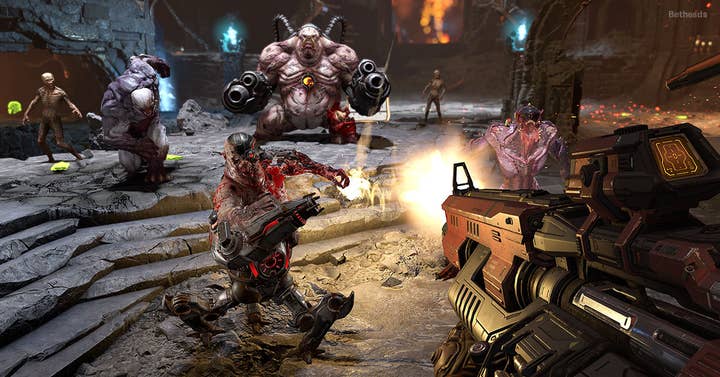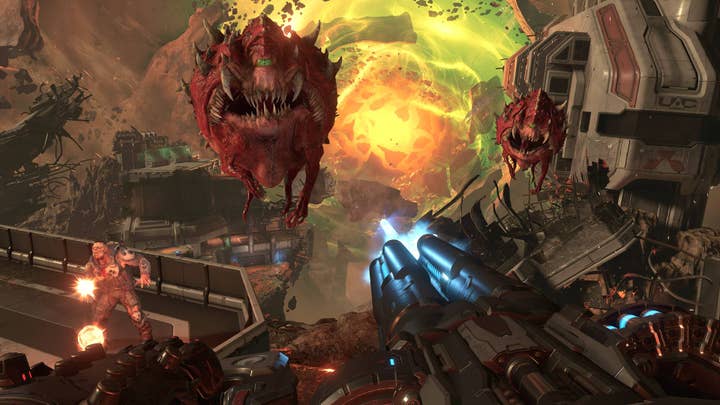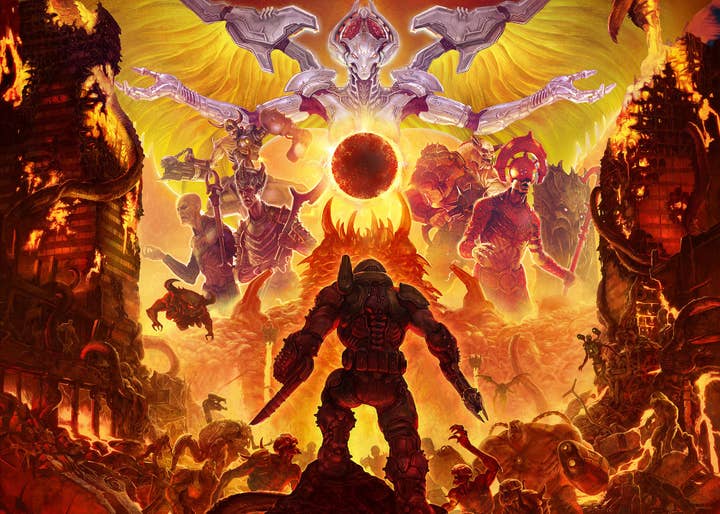Doom Eternal: Critical Consensus
Id Software's latest shows brilliance in its bombast, but dabbles in platforming and world building with less success
In truth, there are no real "droughts" in the games industry release schedule. Actual dry spells are a phenomenon that started to die around the time that Geometry Wars and Castle Crashers were released, and had vanished into dust by the launch of the App Store and the advent of Steam Greenlight.
Despite the ceaseless flow of products on every platform, though, there is still a tendency among engaged gamers to complain of having nothing to play whenever the AAA machine grinds to a halt. The start of 2020 has been one such period, and it's hard to recall an alleged fallow period being brought to a close in such fine style -- two months in the desert, only to emerge to Ori and the Will of the Wisps, Animal Crossing: New Horizons, and Doom Eternal in the space of two weeks.
Like Ori and Animal Crossing, you will struggle to find a single bad Doom Eternal review from any major outlet. All three games are hovering around 90 out of 100 on Metacritic, but that is where the similarities between id Software's latest and its decidedly cosier counterparts ends. If there is one abiding takeaway from every single available critique of Doom Eternal, it's that it manages to surpass the frantic, fluid action of the 2016 reboot -- already one of the better first-person shooters of the last five years.
"Dealing with a particular demon assortment is akin to a real-time resource management puzzle game"
Ars Technica
For IGN's Ryan McAffrey, Doom Eternal manages to combine both "thoughtful design" and "dumb fun" with consummate skill. The speed of movement, the feel and feedback of the weapons, the mechanical balance of risk and reward -- all of it makes Doom immediately satisfying to play, but Eternal asks for more tactical thinking than its predecessor.
"Yes, blasting and ripping demons literally in half with your bare hands is a gleefully, gloriously stupid power fantasy, and Doom Eternal teaches you how to do it better, faster, and in multiple ways as you go -- it makes you a smart Slayer."
McAffrey added: "And when you've got all those monsters gunning for you, Doom Eternal does something unexpected: it starts to get intellectual in the midst of its carnage. To be effective, you need to start to read the defense like a quarterback at the line of scrimmage, and timing is everything."
Ars Technica's Kyle Orland offered a similarly glowing appraisal of Doom Eternal's mechanical finesse. Honestly, you could pick any review at random and find these basic ideas, articulated with greater or lesser style and verbosity, but Orland conveys the thrilling challenge of the game's combat as well as anyone.

"Efficiently dealing with a single room's particular demon assortment is akin to a real-time resource management puzzle game," Orland wrote. "Each enemy type has its own particular vulnerabilities-which the game explains to you rather bluntly on your first encounter-so you have to switch weapons constantly to conserve limited ammo.
"Keeping all this straight in your head as you constantly bob and weave away from threats on all sides can feel a bit overwhelming, even for veterans of the last Doom. Stick with it, though, and things will eventually click. You will become a finely tuned stimulus-and-response machine, flowing through challenges that would have felt completely impossible just a few gameplay hours before. The action is balanced on the edge of going completely off the rails, with just enough health refills and areas of relative calm for a careful player to get their bearings before the next onslaught."
"Interiors are extravagant and interconnected, packed with fine details... A Doom with a view"
VG247
I suspect that, for a large chunk of Bethesda's target market, the confirmation that Doom Eternal provides more-of-the-same-but-better will justify a day one purchase -- and that, it should be noted, is a fine achievement for id Software's developers. However, it's impossible to overlook another common undercurrent in the game's reviews; the idea that, in trying to add to the series' rip-and-tear formula, Doom Eternal stumbles a little, even if those missteps are taken in pursuit of worthy goals.
VG247's Kirk McKeand noted that, in addition to setting a new standard for the series in terms of gunplay, id Software has also opened up the game's environments.
"Here the arenas feel more organic, like part of an environment. They're more open, more layered, and there are more routes through them and more environmental hazards to take into account. They are large enough and with enough routes through to feel boundless, yet still flowing.
"There's much more visual variety here as well. You'll walk across the weapons of long-dead titans, and into the chest cavity of a murdered giant. You'll traverse lakes of molten lava, ascend to the heavens, look out into space, and see Hell on Earth both from ruined cities and the Arctic - literally Hell frozen over. Interiors are extravagant and interconnected, packed with fine details: statues with gold inlays, reflective materials shimmering in the light, elaborate door mechanisms, and mechanical contraptions snapping and whirring into place. It's a visual step up -- a Doom with a view."

But this expansive approach requires solutions for traversal, which are generally agreed to be a mixed bag. For McKeand, the most egregious seems to be a handful of misjudged areas involving swimming. "Let me get this out of the way," he wrote. "Doom Eternal does not need swimming sections. They are easily the low point of the entire game. They're mercifully short and sparingly used, but swimming is clunky and annoying."
For USGamer's Mike Williams, the larger environments marr the perfection of the combat due to a greater number of platforming sections -- a small part of Doom in 2016, but a major and often unwelcome distraction in Eternal.
"You aren't required to listen to the audio diaries, or dip into the codex. But these elements drag on you nonetheless"
Eurogamer
"Platforming is a much bigger part of the experience now, and it's not always great, as I frequently found that the level design and environmental art would obfuscate the way forward," Williams noted. "There was one section where I had to jump from platform to platform, with whatever platform I was currently on falling into the void -- a conceit hearkening back to the days of Mario on the NES.
"On two of the jumps, I couldn't look around in time to know where the next jump was, meaning I had to take a leap in a random direction or just fall into the bottomless pit. The penalty is just some health, but that doesn't excuse it not having a clear way forward."
The abiding impression is of an experience in which the core loop is so brilliantly executed that it casts a harsh light on the areas where id Software is rolling the dice to add variety, texture and flavour. Eurogamer's Edwin Evans-Thirlwell is one of several critics to find fault with Doom Eternal's greater emphasis on lore and world building. The story, such as it is, "feels hopelessly grafted on," and there's a great deal more of it to contemplate than in the first game.

"The cutscenes are now a mix of first- and third-person, which means the Slayer is a fully tangible human being...rather than a pair of enormous fists twitching beneath your aiming reticle... There's some effort to explain the character's superhuman prowess, with one scientist suggesting that you represent humanity's rage to survive, as opposed to humanity's love of making Cacodemons pop in slow motion. The Slayer even has a voice these days, though I think he strings together maybe five words in total.
"True, our man in green never looks happy with all the attention, stomping impatiently through cinematics while other parties monologue at his retreating head... Nor are you required to listen to the audio diaries, or dip into the codex. But these elements drag on you nonetheless, like the lakes of purple goop that stop you running or jumping in certain levels. They're a deflating reminder that you are no longer here just to indulge your baser instincts.
"Conversely, the developer's guilty awareness that people don't play Doom for the narrative means that when you do dig into the world-building, you'll find it to be scanty and by-the-numbers: a set of tired references to ancient races, legendary battles and fallen cities."
In the parting shot of its review of the original Doom in 1994, the venerable Edge magazine lamented its laser focus on combat with the now infamous line: "If you could only talk to the monsters." More than 25 years later, Doom Eternal's attempts to manoeuvre outside of that finely honed action, to provide narrative weight and character motivation, are the impetus for its only significant flaws.
Talking to the monsters is not such an enticing prospect, then -- not when shooting them in the face can be so endlessly satisfying.

